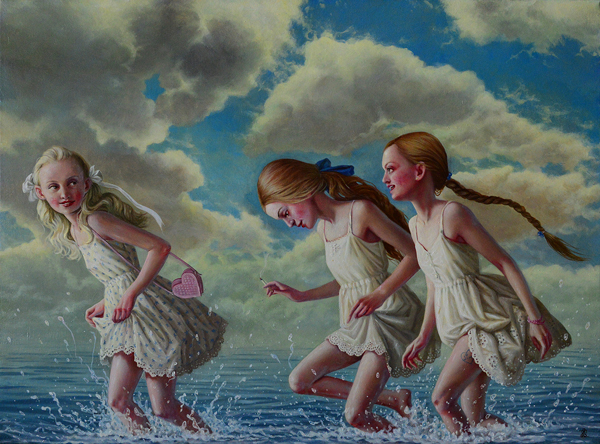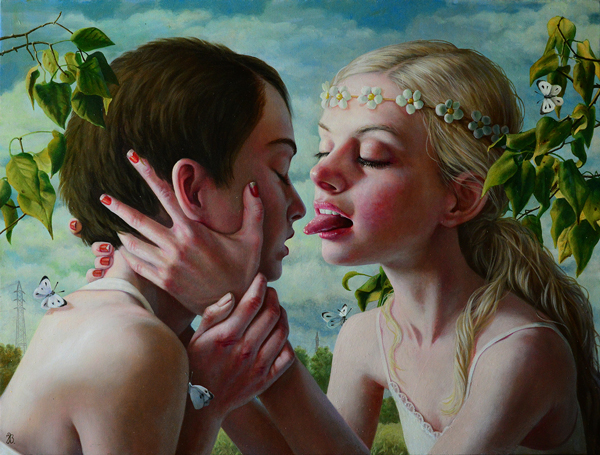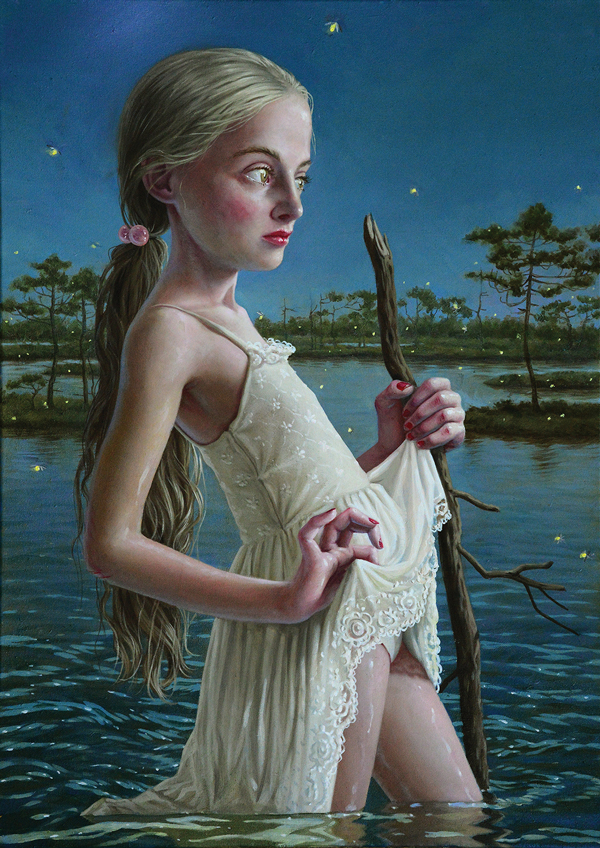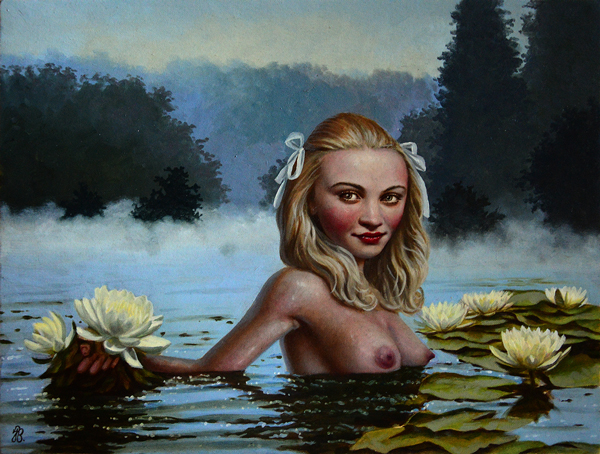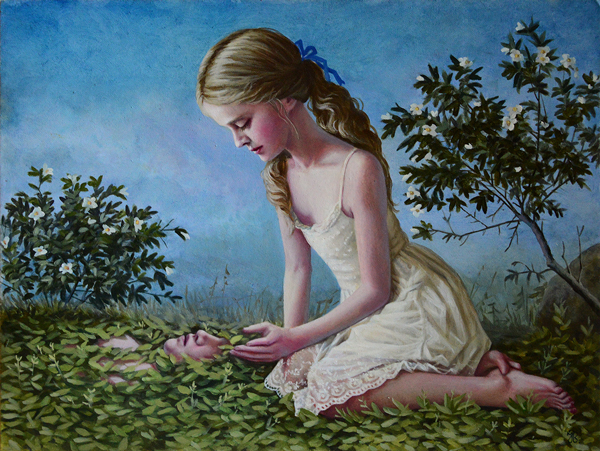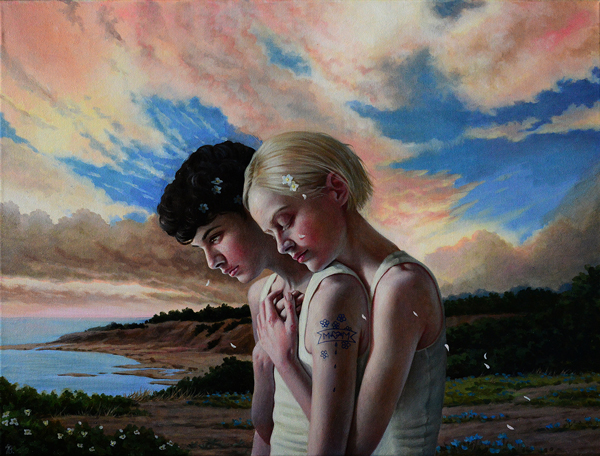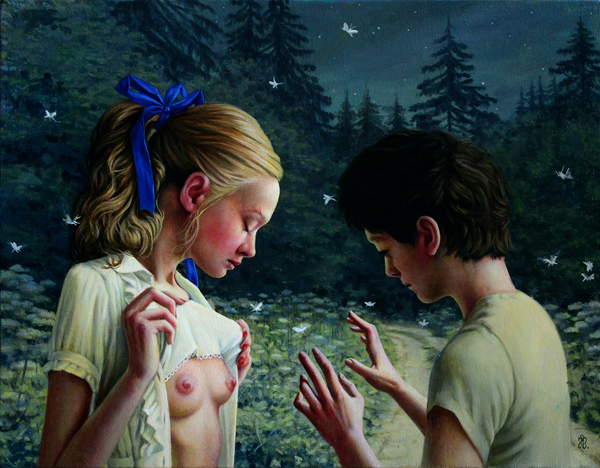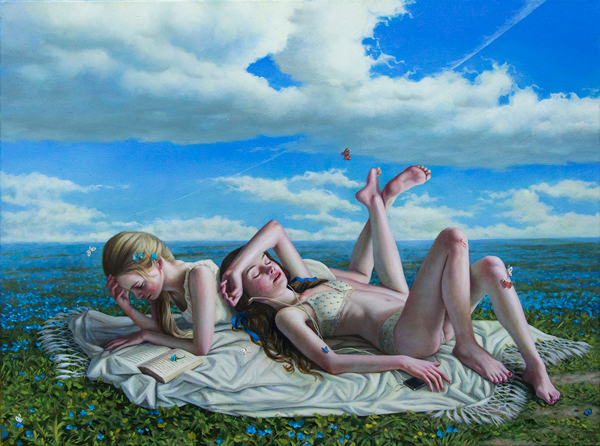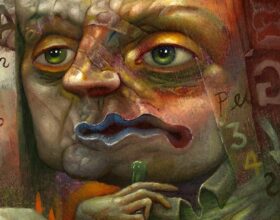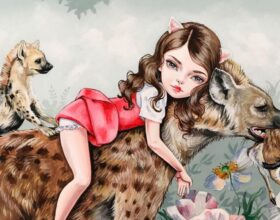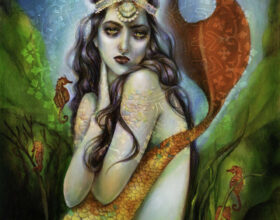“These fragments I have shored against my ruins” T. S. Eliot
For those of you familiar with Jana’s work you’ll understand its magic seems to pierce into the heart of you and touch something that goes well beyond words. It does it gently at first, stirring and softly nudging you awake. Before this interview, I was captivated by Jana’s upbringing in Latvia, a place devastated by Soviet occupation. I thought I understood where her girls got their raw-torn beauty. I pictured us conversing about her work with our toes dipped in icy lakes on the forest edges. I imagined Jana to be as delicate and as softly spoken as her subjects. What I found, however, radiated well beyond those first impressions and can be glimpsed in that part of her girls where their vulnerability is balanced by a poignant sense of wisdom. They almost seem to swell into their fragility, filling it up with a disarming sense of strength. Beneath their flesh run veins of liquid silver.
This November Jana is exhibiting her new series, “Anatomy of Innocence”, at Copro Gallery. There’s a playfulness that has bubbled up in her work and it catches in the back of your throat like a nervous giggle. A breathtaking awkwardness that would be hard not to recognize somewhere within yourself. Like the title suggests, it is an exploration of innocence and it goes well beyond pastel delicacies into something a little more bruised. I feel like this inquiry cuts tenderly with a scalpel, going well beneath the skin. There’s a haunting nostalgia that somewhat reminds me of Sofia Coppola’s, “Virgin Suicides” but Jana’s work slices through the haze. There’s a pulse, a nuance and a blushing fleshiness that grounds the stuff that dreams are made of.
To own some of Jana’s work in print, check out Issue 10 of our very own beautiful.bizarre art book. Stay enchanted on Jana’s facebook and keep up with the exhibition at Copro.
This interview leaves me head over heels. I invite you to tumble down too . . .
‘Anatomy of Innocence’
Opening Reception:
November 7, 2015 | 8 – 11.30pm
*Artist will attend
Exhibition Dates:
November 7 – November 28, 2015
Copro Gallery
2525 Michigan Ave. T5 | Santa Monica, CA 90404
Kissing lessons behind the school shed
I can see how the geography and history of your upbringing softly whispers through each work on such a gentle level. Like landscapes are often infused with their mythologies there’s a certain level of “spirit” in your work. What really fascinates me is how rare visual imagery was in your childhood. I could only imagine what it must have been like to get your hands on an illustrated children’s book or even seeing religious iconography. To me this comes across in your work today. There’s a certain level of sacredness to it. There’s a keenness and a revelation. Can you tell me more about this?
I’m not sure I know the meaning of sacred as opposed to the profane. As I see it, every single breath you take is sacred. So yes, images are sacred too. I talk through images. In this contemporary world, and especially big cities, everybody seems to live quite lonely within their own little world within their head. They often never really open up enough to actually meet one another. I meet people through my images, the people I can really deeply connect with. That interaction is about feelings and emotions, which is a thing we rarely communicate. It is through multi-value metaphors which leave open enough space for your own meanings. They are triggers to relate on a deeply human level. I approach them as personal icons of subjective experiences.
Regarding my childhood, it has taught me some big lessons which I feel are very valuable, and which would have taken way more time if I had grown up in a more sheltered environment. I feel it very keenly that life is worth living only when you live for what you truly believe in, as an individual, for your own personal life. If I were put in a system where I wouldn’t be able to live for what I believe in, I wouldn’t mind dying to make my own statement. I don’t have much of a survivalist or conformist mentality. Growing up in a totalitarian regime in an occupied country till my early teens, I got to learn that some external power can manipulate you only as long as you are in survival mode – afraid for your life, doing a ridiculous job that is against your better judgment or sometimes even against the personal sense of ethics to earn for food and survive. As soon as people were sickened by their slave life to the point where they would rather die than go on with it – they were a leap closer to freedom.
I love your notion of Innocence. I think often our culture deals with it on its most shallow level. I looked up the actual etymology of the word and it stems from the Latin word Innocentia, “to be free of guilt, lacking in guile or artifice, to be free of blame”. To me this also speaks of being free of shame. Your subjects aren’t quite children. It’s like they’ve gone through the shame and come out the end with a deeply wise level of self understanding and innocence in its truest sense of the word. Can you tell me your thoughts on this?
I agree with you. Our culture often perceives and romantically glorifies innocence as simplemindedness, ignorance in basic ways of life, a lack of knowledge. It’s often depicted that the loss of it is painful, a sad loss of some sort of unspoiled virtue. Illusion is not a virtue to me, and losing it means regaining balance and possibility for a broader perspective. We like to have that illusion, it feels safe, like burying your head in a pillow. Freedom feels like a lonely place where just cold gales reign in comparison. Being brave enough to at least wish it, or even try to step out into it I consider very important.
The title for my new body of work is “Anatomy of Innocence”. It’s a concept that is important for my cognition of life, and always has been.
To me innocence is living with openhearted immediacy. It is living out your wildest dreams. It is courage. It is true freedom that is not mistaken just for little liberties, and it is the ability to truly love that which is not mistaken for living in illusions about another. And at the same time it is to play, enjoying the moment with fully open senses like there is no tomorrow. To me it means to stop trying to squeeze your huge shining supernova of a heart into those little gray boxes that are marked as “what we expect of you” or “appropriateness” and so on by society, and living a full life of full experiences.
Goodbye Eden
This brings me to sexuality/femininity in your work. Rather than being objectified, your subjects seem to have a deeply internalized experience of their own sexuality. It’s not for the viewer but rather something we get a glimpse of. It still remains somewhat ambiguous and indefinable. Only for the subject to truly know and experience. Their femininity is also multi-faceted. There’s a softness, a gentleness but also something wild, even harsh and unknown. Is this something you consciously hope to achieve in your work or is it something more intuitive?
The sexuality of a woman has been – and still is – owned by men in our culture. In art, movies, commerce, fashion etc and thus popular culture – which we take as an axiom – female sexuality is defined by men for the most part and squeezed into their mental standard box. Everything that falls over its narrow edges, is cut off. We look at ourselves through the eyes of a male to decide if we look “sexy” for them, and that is for the most part seen as the sexuality of a woman. Male sexuality is self-centered, female sexuality is off-center, and it is harming for both. (Of course, it is not always the case, I talk of tendencies which I have had serious issues with in my personal life).
In my late teenage years, I tried to comply and it felt awful. I felt so disconnected from my own body, which through this objectified approach is mentally owned by another. So I often rejoin my own self through touching on sexuality in a way that is fully owned by me and is creative, through art. But femininity is of course much more than just sexual. And I do feel we need to reconnect to that wild free intuitive aspect, stop fearing it and fall back in love with it again.
An important theme for me is “Virgo the Virgin” in the original sense of the word, (especially having it as my birth sign). The word itself is Latin with an approximate meaning of strong, self-contained, and self-sufficient. It was originally attributed to women who were not married, thus not a property of a man. They were free to determine themselves: mythical goddesses like Diana, temple priestesses or prostitutes. It did not mean sexual “chastity” but sexual independence and the self-determination of a woman. So a “virgin mother” which is a persistent myth through many cultures, may originally mean nothing close to immaculate conception at all, but rather it’s about a free woman giving birth. Symbolically, if the feminine in us is enslaved, abused, owned and ordered around as a property, it cannot give birth and rise to a hero. And every other meaning may just be distortions by cultures that have wanted to manipulate us into willingly giving away our self-power.
The water lily
It’s so fitting that you describe your work as visual poems. They actually do remind me of haiku or a zen koan. Enough openings are provided to give us a doorway into something so subtle and beyond words. To me this seems like a fine line to achieve. You capture the hint of a narrative, an emotion . . . your work is like trying to describe a word on the tip of my tongue. How do you go about achieving this? What are the things you decide to leave out of your work?
Actually one of the main things to remember is to do less reasoning and mental constructing, and rely much more on instinct and intuition. I personally do not enjoy the feeling of an artificially made-up composition and narrative. It feels pushy and tedious to me. I like to have a breathing space around an art work, a space that lets you come up with your own thoughts, not to adopt mine.
As for when to finish, one of the principles I try to keep in mind is that ‘less is more’. I often remove much of the details, characters and things from a nearly finished work, to the point where to remove even more of it would destroy the whole idea and feeling. There I stop. The process is creative and changing till the last second.
There seems to be such a fluid quality to the autobiographical nature of your work. Always moving, always evolving, fleeting moments from a floating world. The world feeds you and you feed it. Reciprocal and undulating. How does this effect your creative process? Does it ever feel like you’re trying to catch up and stay on the wave?
My work is autobiographical, but at the same time I have always had difficulties identifying just with this persona “Jana Brike” and her conditioning. I feel it is a creative play, just one little perspective to experience one version of life out of countless gazillions.
In the deepest sense, I always feel like there is nothing fundamental to catch. The mass consensus of the contemporary world wants to make you think that the life is so fast and you are always missing out on something terribly important, but to me this is an illusion. You are always here, in the present moment of your life. Can you really run from it to some other place? The things that flow and change are the countless shapes and forms we are trying to comprehend, experience and identify with. Their beauty and meaning is in change. There is nothing to catch up too. They come and go. Even in this contemporary trend for spiritual awakening, there persists this idea that you need to catch up to your true self somehow. Which is so false, as the true self is absolutely present exactly in this current moment. And from this position, it is so much easier to create any experience you want to have in your own personal life.
When I feel like I am trying to catch up to something, I just know I’m off balance and going somewhere astray mentally. Then I take at least a few hours off any responsibility to re-center myself. Not to be a little gnat who tries to stay on the wave, but feel myself as the whole ocean.
Gardener’s Son
You speak of your own personal satori experiences, the out-of-body, the beyond word or even thought. Many of your pieces manage to have an underlying pulse of these themes. Yet as an artist myself – deep truths like these seem like such a daunting task to grapple with artistically. Do you ever feel intimidated by them? By the level of truth you’re working with?
Oh, I cannot convey such truths through narrative, either verbal or visual, I don’t even try. These truths are highly individual, intimate and personally experiential, and cannot be directly conveyed to another. Living them thoroughly in your own life is the best way to convey them. My most powerful and unforgettable experiences have been when I feel only as a presence, as a witness, a blank space through which all images and even self-image flows through, without identifying with anything. Where the only thought I can hold as true is “I am”. Any adjectives are too inconsistent and faulty. How can I paint the true self beyond images if a painting is the very essence of image itself? Even a black square is an image of something.
So I hold this position only to “charge” my art, not to try to convey the message directly. Painting is playing. I would stop doing it as soon as it is not joyful to me anymore. And I stay down to earth with it. Whatever the individual contradictory beliefs of people are, we still live a life for the purpose of experiencing our “beingness” IN the body, not out of it. So much of my work and especially lately is to celebrate it, the full range of human emotions, conditions and experiences as a play, not some dogmatic truth. As I see it, the personality with all its ego, conditioning, adventures and life is a little beautiful blossom that we grow inside this space of our beingness. There is no reason either to eradicate it, or to constrain our perception of “self”. Just take care that it is indeed a blossom, not a stinky weed. In many ways, this blossom is what I paint.
Where the wild roses grow
Tell me about your latest solo exhibition showing at LA’s Copro Gallery this November?
I have 17 new paintings, inspired by love, by human touch – raw, vulnerable, clumsy, trusting, open, awkward and eager. About closeness, intimacy and opening up to another on a very woundable level. Loneliness has been a very substantial theme of my work my entire life, it has always been so hard for me even to incorporate more than one character in a painting. I feel it’s time to walk half a step out of this.
It is autobiographical in some weird twisted way, and tells about the youth and first love that I never really had in my own life in this way. It is a fever, a dream of adolescence, nostalgia, something of that feeling about how a teenage girl mystifies boys and her own bodily experiences. How that first touch, although eager, is also full of awe and intimidation. It is completely childlike, but at the same time, I as an adult feel this theme is extremely topical at my current moment because you never again touch another in the same way as then: without projecting your own lifetime of failures and pain on them, without expecting the worst and holding your guard up, without having to battle through the protective walls of another to have this twinkling experience of a raw open true touch.
I am of course not inviting you to return into the simplemindedness of youth against your will and better judgement. There is no way back in life, only forward. It is the same as we talked about the innocence concept. Maybe it just requests this full circle – a lifetime of pain, disappointment, smashed expectations, heartbreak and attempts to shore your heart up again, and break it again and again. And then, when you have no expectations to prop up anymore because they always fall, and you do not try to solidify the shell of your heart anymore because it always breaks anyway, and you have nothing, nothing at all to lose, then you are ready again for this pure raw open touch with someone who is exactly the same. And that is enlightenment.
Looking at your entire body of work I’ve noticed how your subjects continue to evolve and change. Some of them have seemed beautifully raw and vulnerable . . maybe even a little war-torn. Others have seemed curiously alien, some are a little playful and a few have their guard up. Can you see an overarching narrative across all of your work? How are your subjects evolving? And what are they morphing into next?
They are morphing from aliens into earthlings, just like me *smile*.
So simple but so huge. In a sentence or two – tell me . . . Why do you paint?
First of all – also simple but huge – because I truly like to!
Also, I fully believe I need to focus on what I really want to experience, and manifest what I think important and necessary. For me very personally it is beauty and harmony, and free creativity. There are many people whose beautiful and necessary passion is to help people survive – provide plenty of food, health, shelter and so on. I on the other hand, have always felt my personal input is to focus on the purpose, on what to survive FOR.


